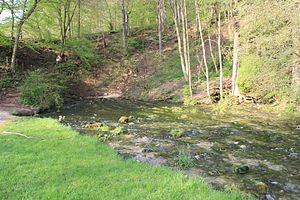Origin of the black stove
| Cooker origin | |||
|---|---|---|---|
 The origin of the black stove |
|||
| location | |||
| Country or region | Ostalbkreis ( Baden-Württemberg ) | ||
| Coordinates | 48 ° 46 '19 " N , 10 ° 5' 43" E | ||
| height | 499.2 m above sea level NHN | ||
|
|||
| geology | |||
| Mountains | Swabian Alb | ||
| Source type | Karst spring | ||
| Exit type | Hill debris source | ||
| rock | White Jura | ||
| Hydrology | |||
| River system | Rhine | ||
| Receiving waters | Schwarzer Kocher → Kocher → Neckar → Rhine → North Sea | ||
| Bulk | 680 l / s | ||
Coordinates: 48 ° 46 ′ 19 " N , 10 ° 5 ′ 43" E
The origin of the black stove , even Kocherursprung called, is a karst spring in Oberkochen in Ostalbkreis in Baden-Württemberg .
Surname
The origin of the black cooker is often shown on maps with the grammatically incorrect designations “Schwarzer Kocher Ursprung” and “Schwarzer Kocherursprung”.
geography
The karst spring is located south of the city of Oberkochen at 499.2 m above sea level. NN on the western valley slopes. The springing there cooker swelling river flows through the Urbrenztal in northeast towards Unterkochen where it joins the White stove combined.
The Schwarze Kocher rises here very close to the European main watershed - because the Ziegelbach begins just two kilometers further south and flows in the opposite direction over the Brenz to the Danube . The federal road 19 and the Brenzbahn run through the valley very close .
The origin of the Schwarzer Kocher is the start and end point of the Oberkochen route of the Karstquellenweg .
Data
The origin of the black stove has several source dropouts, which cut deeper and deeper into the mountain. The spring water comes from the rubble and the well-stratified limestone of the White Jura , which pour an average of 680 l / s here ; Depending on the season and the weather, the value fluctuates between 50 l / s and 4000 l / s. This river origin is the largest karst spring in Oberkochen.
The active erosion forces of the water are clearly visible on the original dump. The catchment area is almost 100% forested and hardly populated, which is why the water is very clean. Occasional cloudiness with high discharge originates from the underground fissured aquifer .
Environment and nature protection
The origin of the black stove is a protected natural monument . In the wetland numerous protected living plant and animal species . The various types of lush green plant cushions extend to the urban area of Oberkochen in the Schwarzen Kocher .
history
From 1551 to 1644 there was an ironworks at the origin of the Kocher . After its destruction in the Thirty Years War , a slag washer was operated there from 1646 to the middle of the 18th century . Dark cinder residue in the river bed is said to be the reason for the name "Black Cooker".
The name of the "Schmiedestein" (also: "Schmidtestein" or "Schmiedefels"), a rock group directly above the source of the Kocher at 620 m above sea level, also reminds of the earlier iron smelting. NHN, in which there is a cave designated as a cultural monument . It is a dolomite rock group in the White Jura , where bizarre shapes have emerged as a result of the rock's different weathering stability .
photos
Further sources at Oberkochen
- Brunnenquelle (in the Brunnenhalde)
- Edlenbachquelle (in the nursery in the "Langen Teich")
- Hubertusquelle (in Tiefental)
- Hunger well (in Wolfertstal)
- Katzenbachquelle (at the municipal cemetery)
- Langertbrunnen (in Wolfertstal)
- Luggenlohbrunnen (in the Spitztal)
- Neubrunnen (in Wolfertstal)
- Origin of the red cooker (oil pond)
- Origin of the White Cooker (in Unterkochen)
See also
Web links
- Detail map of the origin of the black cooker and its surroundings on: State Institute for the Environment Baden-Württemberg (LUBW) ( Notes )
- Geotope profile origin of the Black Cooker (PDF, 359 KByte) on: Mapserver of the State Office for Geology, Raw Materials and Mining (LGRB) ( Notes )
- Geotope profile forged stone with cave (PDF, 359 KByte) on: Mapserver of the State Office for Geology, Raw Materials and Mining (LGRB) ( Notes )
- Cooker origin
Individual evidence
- ↑ Information board: Origin of the stove
- ↑ Origin of the Black and White Cooker ( Memento of the original from June 1, 2009 in the Internet Archive ) Info: The archive link was inserted automatically and has not yet been checked. Please check the original and archive link according to the instructions and then remove this notice.
- ↑ Dietrich Bantel: Iron forge at the origin of the cooker on heimatverein-oberkochen.de. Retrieved January 12, 2019.
- ↑ Dietrich Bantel: The four largest Oberkochen caves. In: City of Oberkochen, Mayor Harald Gentsch (Ed.): Oberkochen - history, landscape, everyday life. Oberkochen 1986, ISBN 3-9801376-1-9 , pp. 286-292 , here: p. 288.
- ↑ Dietrich Bantel: The cave in the forged stone on heimatverein-oberkochen.de. Retrieved February 26, 2019.








